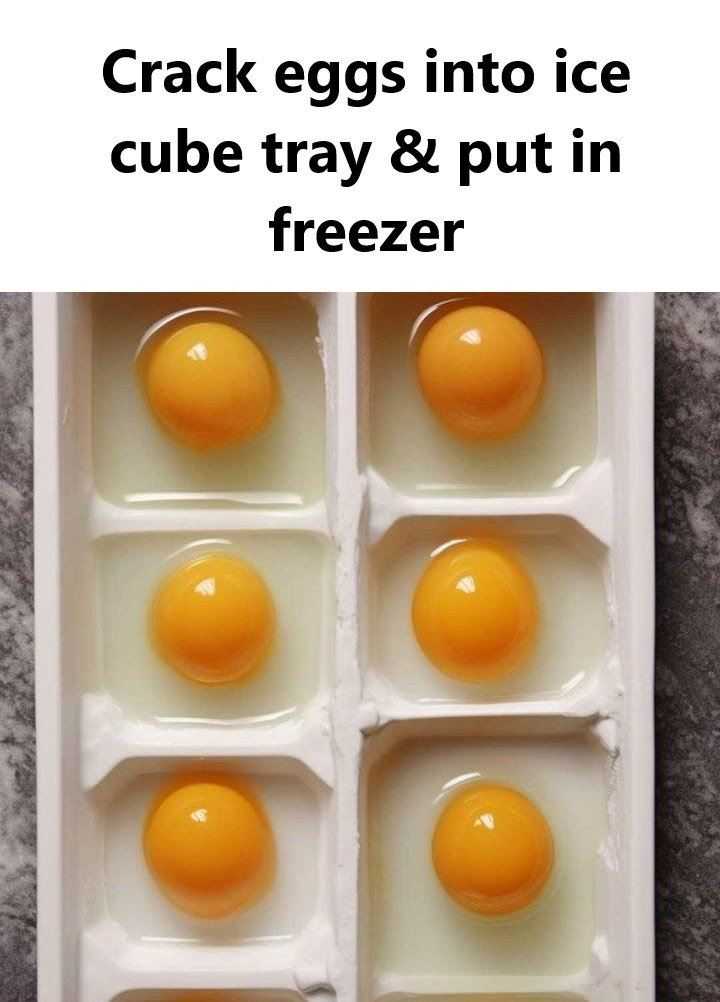ADVERTISEMENT
How to Freeze Eggs in an Ice Cube Tray
Freezing eggs in an ice cube tray is incredibly easy, and you don’t need any special equipment. Just follow these simple steps:
Step-by-Step Guide:
Step 1: Crack the Eggs
Start by cracking your eggs into a bowl. Depending on the size of your ice cube tray and how many eggs you want to freeze, this will determine how many eggs to crack. A standard ice cube tray typically has 12 compartments, so you can freeze one egg per compartment.
Step 2: Whisk or Keep Whole
You have a choice here: you can either whisk the eggs lightly to combine the yolks and whites for a scrambled texture once thawed, or you can leave them whole if you plan to use them for frying or baking later. If you prefer scrambled eggs or omelets, go ahead and beat them a little. Just remember, if you leave them whole, it might take a little longer to thaw, and the texture might be slightly different once cooked.
Step 3: Pour Into the Ice Cube Tray
Carefully pour the egg mixture into each compartment of the ice cube tray. Don’t overfill; leave a small amount of space at the top to allow for expansion as they freeze.
Step 4: Cover and Freeze
Cover the ice cube tray with plastic wrap, a lid, or parchment paper to avoid any freezer smells from affecting the eggs. Place the tray in the freezer and let it freeze for at least 2-4 hours, or until the eggs are completely solid.
Step 5: Store the Frozen Eggs
Once frozen, pop the egg cubes out of the tray and place them into a freezer-safe, airtight bag or container. Label the bag with the date, so you can keep track of how long they’ve been stored. You can also store them in smaller portions if you know you’ll use a certain number of eggs at a time.
How to Thaw Frozen Eggs
Thawing frozen eggs is just as simple as freezing them. Depending on how you intend to use them, you can choose from several methods:
- Refrigerator Thawing: For the best results, place the frozen eggs in the refrigerator for several hours or overnight to thaw.
- Quick Thawing: If you’re in a rush, you can place the frozen eggs in a bowl of cold water for 20-30 minutes to thaw them more quickly.
- Microwave Thawing: For fast thawing, you can microwave the eggs in short intervals, stirring occasionally, until they’re fully thawed. However, use this method carefully to avoid cooking the eggs in the microwave.
How to Use Frozen Eggs
Frozen eggs are incredibly versatile, and you can use them in a variety of ways. Here are some ideas on how to make the most of your frozen eggs:
- Scrambled Eggs or Omelets: Simply thaw the eggs, scramble them, and cook them as usual. If they were beaten before freezing, this will work especially well.
- Baking: Eggs are a common ingredient in baking recipes, and frozen eggs work perfectly in cakes, muffins, cookies, and other baked goods. Just thaw them before adding to your batter.
- Casseroles and Quiches: If you’re making a casserole or quiche, frozen eggs work wonderfully since they’ll be mixed with other ingredients, and you won’t notice any change in texture.
- Fried Eggs: If you prefer fried eggs, just crack the thawed egg into a hot pan as you would a fresh egg. Keep in mind that it might not have the same consistency as a freshly cracked egg, but it will still work.
- Breakfast Sandwiches or Burritos: Freeze the eggs in advance and use them to quickly assemble breakfast sandwiches or burritos when you’re in a time crunch.
Tips for Freezing Eggs
- Don’t Freeze Eggs in the Shell: It’s important not to freeze eggs in their shells, as the shells can crack during freezing, causing a mess. Always crack the eggs first and freeze them in a container.
- Use Within a Year: For the best taste and texture, aim to use frozen eggs within a year. After that, they may lose some of their quality, but they will still be safe to eat.
- Freezing Egg Whites and Yolks Separately: If you only need one part of the egg, you can separate the whites from the yolks and freeze them individually. Just make sure to label them so you know which is which.
Conclusion: A Simple and Effective Way to Store Eggs
Freezing eggs in an ice cube tray is a quick, easy, and cost-effective way to preserve eggs for later use. Whether you have leftover eggs or want to buy in bulk, this method allows you to store eggs for months while maintaining their freshness and versatility. It’s especially useful for busy households, bakers, meal preppers, or anyone looking for a more convenient way to use eggs.
By using an ice cube tray, you can also ensure your eggs are conveniently portioned out, so you only use what you need without defrosting more than necessary. Give it a try and discover just how useful this simple method can be!
ADVERTISEMENT
